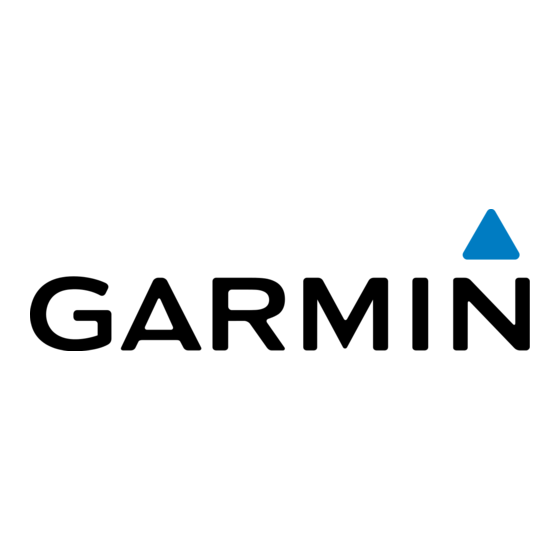Garmin VHF 215 AIS Series 소유자 매뉴얼 - 페이지 13
{카테고리_이름} Garmin VHF 215 AIS Series에 대한 소유자 매뉴얼을 온라인으로 검색하거나 PDF를 다운로드하세요. Garmin VHF 215 AIS Series 37 페이지.
Garmin VHF 215 AIS Series에 대해서도 마찬가지입니다: 설치 지침 매뉴얼 (4 페이지), 설치 지침 매뉴얼 (15 페이지)

Automatic Transmitter Identification
System
Automatic Transmitter Identification System (ATIS) is a vessel
identification system used on certain inland waterways in some
European countries. See your Garmin dealer to program your
VHF radio if you plan to use your radio on waterways that are
within the bounds of the Regional Arrangement Concerning the
Radiotelephone Service on Inland Waterways (the Basel
Agreement). ATIS is prohibited outside the European inland
waterways that are covered by the Basel Agreement.
When you enable ATIS, your radio sends a data signal
identifying your station at the end of every transmission. Data
identifying your position is not sent, but your position is
calculated through the method of triangulation by coastal
stations that receive your transmissions.
To enable ATIS, you must enter your ATIS identification number
(Entering Your ATIS Identification Number, page
on ATIS
(Turning On and Off ATIS, page
dealer to determine your ATIS identification number and to learn
about ATIS requirements for your region.
Your radio disables these functions when you enable ATIS.
• Digital Selective Calling (DSC)
• Monitor two or three channels (Dual watch and Tri watch)
• Scanning channels
International channels 6, 8, 10, 11, 12, 13, 14, 71, 72, 74, and
77 restrict transmitting to low-power (1 W) when you enable
ATIS.
Entering Your ATIS Identification Number
You can enter your ATIS identification number only once. If you
must change your ATIS identification number after entering it,
you must take your radio to your Garmin dealer for
reprogramming.
NOTE: You can access the ATIS settings on the radio after the
ATIS feature is activated by your Garmin dealer.
1
Select MENU > ATIS > MY ATIS ID.
2
Enter your ATIS number
3
Select ACCEPT.
The radio prompts you to reenter your number.
4
Enter your ATIS number again, and select ACCEPT.
If the ATIS numbers do not match, a message appears.
5
If necessary, select RETRY, and enter the number again.
Turning On and Off ATIS
1
Select MENU > ATIS > ATIS.
2
Select ON or OFF.
appears on the screen when ATIS is enabled.
3
Select OK.
Viewing Your ATIS Identification Number
Select MENU > ATIS > MY ATIS ID.
Automatic Identification System
The Automatic Identification System (AIS) is an automatic
tracking system used on vessels and by vessel traffic services
(VTS). It enables vessels and VTS to identify and locate vessels
by electronically exchanging data with other nearby vessels and
AIS base stations. When used with a compatible chartplotter or
multifunction display (MFD), AIS can assist with collision
avoidance.
Automatic Transmitter Identification System
9), and turn
9). See your Garmin
NOTICE
(Entering Text, page
4).
NOTE: AIS is not available on all models.
Turning On and Off AIS
1
Select MENU > AIS.
2
Select ON or OFF.
3
Select OK.
NMEA 0183 and NMEA 2000
When you connect the radio to a NMEA 0183 device or a NMEA
2000 network, you can transfer received DSC distress and
position information to any compatible connected chartplotter
(NMEA, page
11).
The radio can also receive GPS-position information from a
NMEA 0183 device or a NMEA 2000 network. Received GPS-
position information appears on the home screen and is
transmitted with DSC calls.
data is available, and flashes when GPS data is not present.
When GPS data is not present, you must enter your position
manually
(Manual Position Information, page
For more information on connecting the radio to a NMEA 0183
device or a NMEA 2000 network, see the VHF 115/215 AIS
Series Installation Instructions.
Additional Functionality with Other Garmin
Devices
The radio has additional capabilities when you connect it to
other Garmin devices, such as a chartplotter.
NOTE: You may need to upgrade your Garmin chartplotter
software to use NMEA 0183 or NMEA 2000 features.
When you connect the radio to a Garmin chartplotter using
either NMEA 0183 or NMEA 2000, your chartplotter keeps track
of the current and previous positions of the contacts in the
directory.
When you connect the radio to the same NMEA 2000 network
as a Garmin chartplotter, you can use the chartplotter to set up
an individual routine call.
When you connect the radio to the same NMEA 2000 network
as a Garmin chartplotter, and you initiate a man-overboard
distress call from the radio, the chartplotter prompts you to
navigate to the man-overboard location. If you connect a Garmin
autopilot system to the same NMEA 2000 network, the
chartplotter prompts you to start a Williamson's turn to the man-
overboard location.
Communicating Over NMEA 0183 or NMEA
2000
NOTE: This feature is not available on all models.
You can select a connection either to a NMEA 0183 device or to
a NMEA 2000 network. The radio can communicate over only
one communication protocol at a time.
1
Select MENU > COMMUNICATIONS > PROTOCOL.
2
Select NMEA0183 or NMEA2000.
Configuring DSC NMEA Transmissions
You can filter the types of DSC-call data the radio sends to a
connected NMEA 0183 device or over a NMEA 2000 network.
1
Select MENU > COMMUNICATIONS > DSC OUTPUT.
2
Select an option:
• To send NMEA data when you receive a DSC call from
any MMSI number, select ALL VESSELS, and proceed to
the last step.
• To disable sending NMEA data when you receive a DSC
call, select NO VESSELS, and proceed to the last step.
®
appears on the screen when GPS
8).
9
